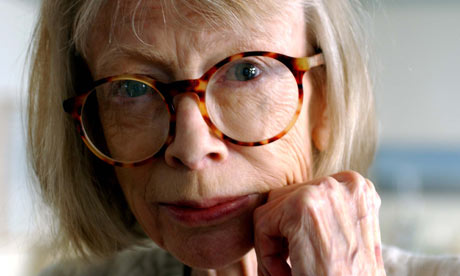those certain females: joan didion
 Feminism is often associated with evident boldness; with head-scarfed women, rolling up their sleeves to boast shapely forearms; a “We Can Do it!” speech bubble floating courageously above their heads.
Feminism is often associated with evident boldness; with head-scarfed women, rolling up their sleeves to boast shapely forearms; a “We Can Do it!” speech bubble floating courageously above their heads.
The figure of Joan Didion—slender to the point of frailty, a slightly anxious expression on her face—runs counter to this intrepid image. Instead, it is her words that lend her power; words which are insightful, satisfyingly sardonic and often beautiful.
Most renowned for her essays, work as a reporter, and more recently, memoirs; her writing gained attention in the 1960s when she covered the demise of the Haight-Ashbury countercultural scene in California. ’San Francisco was where the social haemorrhaging was showing up. San Francisco was where the missing children were gathering and calling themselves “hippies.”’
Her prose style is distinct and lyrical, lauded at the time of publication as some of the best in America; and it is unashamedly fascinated with America itself:
‘It was a country of bankruptcy notices…of casual killings…and vandals who misspelled even the four letter words they scrawled…It was not a country in open revolution. It was not a country under enemy siege. It was the United States of America in the cold late spring of 1967.’
Apart from revelling with hoards of filthy, beanie-wearing San Franciscans, Didion has written on topics as wide-ranging as, John Wayne, self respect, Hollywood, and the nature of good and evil in a Death Valley motel room. She seems consistently interested in chronicling a loss of innocence; in regard to the wilting sixties scene, and in regard to her girlhood self.
In one of her most notable essays ‘Goodbye To All That’, she writes evocatively about being young and moving to the city that people move to when they are young and green and looking for a nebulous sense of life direction: New York. With a sense of resigned nostalgia she describes ‘how six months can become eight years with the deceptive ease of a film dissolve…I enter a revolving door at twenty and come out a good deal older, and on a different street.’ Her words resonate with this loss of innocence, a loss of youth.
In another of her noteworthy essays, ‘On Keeping a Notebook’, she writes about the compulsion of writing, describing it as ‘inexplicable to those who do not share it.’ Which is a sentiment that I think can be used to describe Didion’s writing in general. To people who are socially at ease, who do not identify with the particular neuroses evident in her work at times—the sense of dread, the hints of social ineptitude and insipid self doubt; the bane of countless-writers—Didion’s work may not be so absorbing.
Didion has an interesting relationship with the feminist movement, the second wave of which was happening when she was at the most prolific point of her career. In 1972 she wrote a scathing essay entitled simply ‘The Women’s Movement’, lamenting what she perceived as the fracturing of the movement: ‘…the literature of the movement began to reflect the thinking of women who did not really understand the movement’s ideological base.’ She suggested that certain women influenced by the second wave’s ideals were becoming too precious, and shying away from responsibility—‘This ubiquitous construct was everyone’s victim but her own.’ This essay would surely not have won her many friends at the time, but it is testament to Didion’s strong, insightful thinking, and her assertive writing ability.
More recently she regained a flurry of attention—at the age of 71—upon the release of A Year of Magical Thinking, a meditative work dealing with the sudden death of Didion’s husband, and then soon after, her daughter. The work is lyrical with her familiar deadpan tics. But as an introduction to Didion’s work in general, Magical Thinking would not be the best place to begin. Instead, introduce yourself first to the young—or at least much younger—Joan Didion, the one who isn’t mourning the loss of her husband, but rather the loss of schoolgirl innocence, the outgrowing of a city in ‘Goodbye to All That’.
Didion herself wrote decisively of her deceptive physical stature: ‘My only advantage as a reporter is that I am so physically small, so temperamentally unobtrusive, and so neurotically inarticulate that people tend to forget my presence runs counter to their best interests. And it always does.’ However, despite this neurotic and frail exterior, the strength of her words resonate; proving that anxious, writerly types are equally as important as the outwardly bold female voices. Didion doesn’t need a polka-dot head scarf or muscular forearms to project a sense of strength. All she needs is her words.


Pingback: Those certian females: Joan Didion | Kimberley Thomson